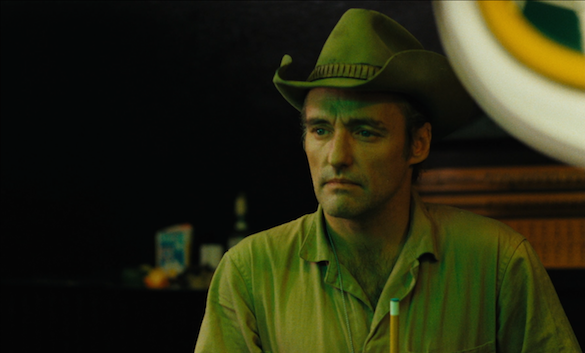
Wim Wenders has always had a fascination with Americana – in his most famous film, Paris, Texas, references to westerns and road movies abound, but before that came The American Friend, a tribute to B movies and Film Noir, masquerading as an adaptation of Patricia Highsmith’s novel, Ripley’s Game.
While there have been many film versions of Highsmith’s character, this is undoubtedly the most purely cinematic of these. Played with a cool detachment by Dennis Hopper, this Ripley is a conman who enjoys manipulating people from behind the scene. He isn’t the amoral, Macchiavellian sociopath you might expect from his characterisation in The Talented Mr Ripley, and seems to enjoy the novelty of making a new friend.
Bruno Ganz (now perhaps best known for his incredible performance as Hitler in Downfall) gives a sensitive, all-too-human performance as Zimmermann, a framer with terminal leukaemia who makes the crucial mistake of slighting Ripley at an auction. This leads to Ripley taking an unhealthy interest in Zimmermann, and getting him involved with French gangsters and an unlikely career as a hitman, all while forming a peculiar friendship with him.
Ganz is exceptional in his role, making what could be a rather boring character incredibly likeable in a handful of early scenes. The first assassination, where he follows his target and makes one schoolboy error after another, only works because we are so invested in his character. By contrast Hopper initially seems a bit wooden, but as the relationship between the two develops, Hopper finds his momentum. The two actors are so different, but the contrast in their styles actually makes their scenes together a lot more interesting, and gives the pair a unique dynamic – they’re not exactly friends, but they understand each other, and their relationship is oddly touching.
Wenders pays homage to old fashioned B-movies and film noir through the beautiful cinematography, consciously old fashioned score and the casting of old Hollywood directors such as Nicholas Ray and Samuel Fuller in minor supporting roles. Like most of Wender’s filmography, The American Friend has a meditative pace, and a detached, cool style which can make it feel like a bit of a slog at times, but it’s a film that’s worth sticking with. The two lead performances alone make it a must see, but on top of that, the cinematography makes every single shot a work of art.

Cinematographer Robby Muller died earlier this year, and this 4K Blu-ray release of The American Friend does a service to his distinctive, cool, crisp cinematography, influenced by Edward Hopper and recalling films like Le Samourai and The French Connection. Muller was a master innovator and this was the first film to make use of neon lighting, which gives the film it’s distinctive look. The quality of the transfer highlights this, and makes even more apparent the influence this film has had on contemporary cinema, and the massive debt owed by films such as Heat and Drive.
A bright, neo noir thriller with an unexpected amount of pathos. The relationship between Zimmermann and Ripley is one built on mutual mistrust but there’s a strange kind of honesty in that, which the film and the performances make some sort of sense out of. Ganz especially makes his somewhat dour character likeable and incredibly sympathetic throughout.
Special Features
Frustratingly there still aren’t any English language subtitles on the Blu-ray, which is a shame, especially when a lot of the dialogue is mumbled or spoken in a naturalistic way. However, the foreign language subtitles have been translated afresh by Wenders so the interpretation is closer to what he intended than in the existing DVD release.
In terms of special features, there is a new documentary on the restoration of Wenders’ films, a commentary from the director and Hopper, deleted scenes with optional commentary and a trailer.
It’s a shame that there isn’t anything that substantial to commemorate Robby Muller on the Blu-Ray, but Wenders does pay tribute to him in a new introduction to the film, specifically his revolutionary use of neon lighting. The real treat though is just watching the film on the 4K transfer – Muller was a brilliant cinematographer and this rendering is a fitting tribute to his work.





